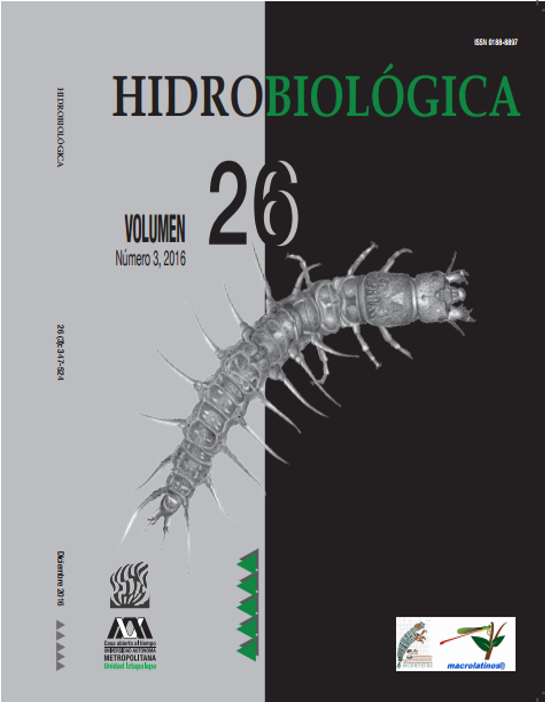Crustaceans diversity of the lower basin river Papaloapan, Veracruz, Mexico
DOI:
https://doi.org/10.24275/uam/izt/dcbs/hidro/2016v26n3/BarbaKeywords:
Basin, crustaceans, distribution, diversity, Papaloapan riverAbstract
Background. Papaloapan river´s lower basin is very important for its extensive wetlands and biota presented. However this area is very impacted by several economic activities (sugar mill and oil extraction) mainly. Goals. The aim of the study was to determine the diversity of crustaceans in the lower basin of Papaloapan river. Methods. The collection of organisms is carried out in the dry and rainy seasons in 2013, diurnal sampling with diverse collectors was apply and registering physiochemical variables of the water in different tributaries of the basin. Results. Río Blanco had the highest salinity and total dissolved solids (2.9 ups and 2704 mg / l) respectively. The lower oxygen concentration was recorded in San Agustín and Blanco rivers (1.009 y 2.09 mg / l) respectively. A total of 4,587 organisms were collected corresponding to ten families, twelve genera and sixteen species. Potimirim mexicana and Hyalella azteca dominated in terms of density with 34% and 26% in dry season, in the rainy season Macrobrachium sp., and P.mexicana dominated in density with 59% y 30% respectively. The greatest spatial diversity in dry season was in Blanco river with (H=0.29) and minimum in Playa Vicente (H=0.37), in rainy season highest diversity was in Sontecomapan (H=1.08), while Blanco river showed the minimum diversity (H=0.29). Conclusions. The macroinvertebrates including crustaceans, are primordial organisms into aquatic systems to play an important role in recycling organic matter and energy transfer to different trophic levels, the knowledge of the dynamic and population structure of this communities and it´s ecology will allow us distinguish between changes by human affectations in aquatic systems and its surrounding and changes produced naturally.Downloads
Downloads
How to Cite
Issue
Section
License
Los autores/as que publiquen en esta revista aceptan las siguientes condiciones:
De acuerdo con la legislación de derechos de autor, HIDROBIOLÓGICA reconoce y respeta el derecho moral de los autores, así como la titularidad del derecho patrimonial, el cual será cedido a la revista para su difusión en acceso abierto.
Publicar en la revista HIDROBIOLÓGICA tiene un costo de recuperación de $500 pesos mexicanos por página en blanco y negro (aproximadamente 29 dólares americanos) y $1000 pesos por página a color (aproximadamente 58 dólares americanos).
Todos los textos publicados por HIDROBIOLÓGICA sin excepción se distribuyen amparados bajo la licencia Creative Commons 4.0Atribución-No Comercial (CC BY-NC 4.0 Internacional), que permite a terceros utilizar lo publicado siempre que mencionen la autoría del trabajo y a la primera publicación en esta revista.
Los autores/as pueden realizar otros acuerdos contractuales independientes y adicionales para la distribución no exclusiva de la versión del artículo publicado en HIDROBIOLÓGICA (por ejemplo incluirlo en un repositorio institucional o publicarlo en un libro) siempre que indiquen claramente que el trabajo se publicó por primera vez en HIDROBIOLÓGICA.
Para todo lo anterior, el o los autor(es) deben remitir el formato de Carta-Cesión de la Propiedad de los Derechos de la primera publicación debidamente requisitado y firmado por el autor(es). Este formato se puede enviar por correo electrónico en archivo pdf al correo: enlacerebvistahidrobiológica@gmail.com; rehb@xanum.uam.mx (Carta-Cesión de Propiedad de Derechos de Autor).
Esta obra está bajo una licencia de Creative Commons Reconocimiento-No Comercial 4.0 Internacional.


